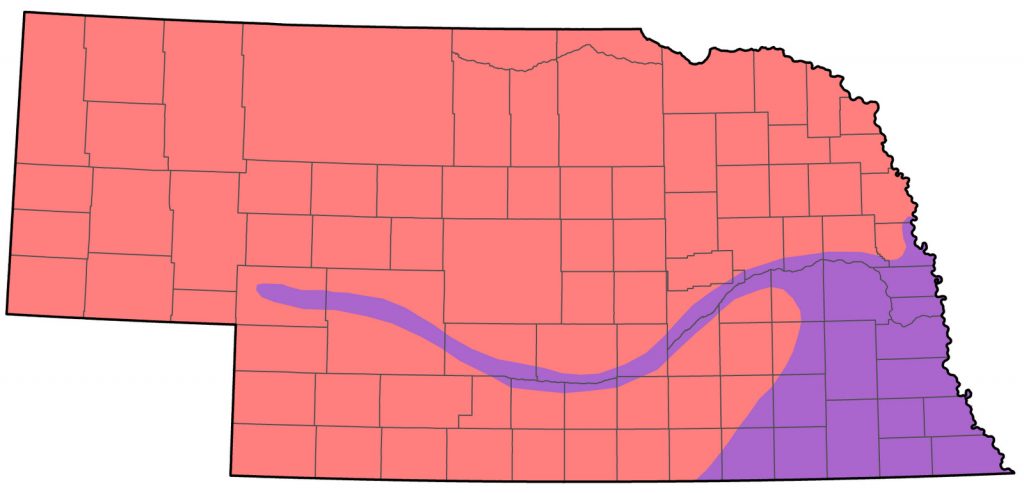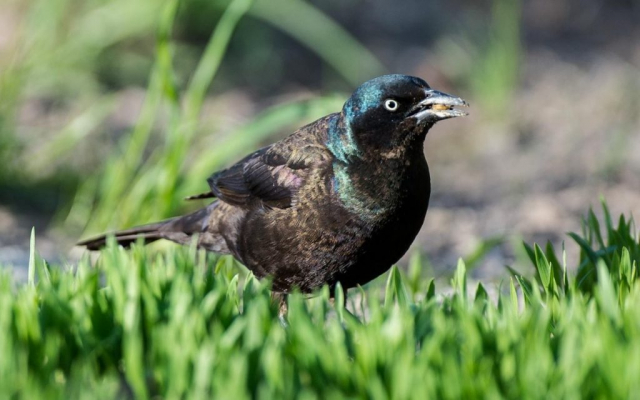Quiscalus quiscula versicolor
Status: Abundant regular spring and fall migrant and breeder statewide. Uncommon regular winter visitor south and east, rare North Platte River Valley, rare casual elsewhere.

Documentation: Specimen: UNSM ZM7029, 25 Mar 1890 Lincoln, Lancaster Co.
Taxonomy: Three subspecies are recognized (AviList 2025): versicolor, breeding from Northwest Territories and northern New Mexico east to Newfoundland and southwest Louisiana, wintering to south Texas and Georgia, stonei, breeding from central Louisiana to Connecticut and North Carolina, wintering to Nova Scotia and northern Florida, and quiscula, resident from eastern Louisiana to southeast Virginia and Florida.
Nebraska birds are versicolor (Pyle 1997).
Jaramillo and Burke (1999) and Peer and Bollinger (2020) consider stonei to apply to birds in a hybrid zone between versicolor and quiscula that has been moving north in recent years.
Spring: Mar 5, 7, 7 <<<>>> summer (north and west)
Earlier dates are included in Winter (below); occasionally presumed early migrants appear in late Feb.
In the south and east, where overwintering occurs, spring movement begins in early to mid-Feb; flocks such as 100 at Funk WPA, Phelps Co 5 Feb 1999, 125 at Nebraska City, Otoe Co 6 Feb 1998, 500 at Grand Island, Hall Co 7 Feb 2013, and a “huge flock” in Lincoln Co 8 Feb 2009, are probably early migrants as wintering birds rarely occur in groups of more than 10-15 birds (see Winter).
Peak movement probably occurs in late Mar (Johnsgard 1980).
Males generally precede females; in Finney Co, Kansas, careful counts by Tom Shane in 2006 showed that 8-16 Mar most were males; females had increased to about 20% by 16 Mar.
- High counts: 11,222 in Lancaster Co 31 Mar 2010, 10,000 there 27 Mar 2017, 6000 in Lincoln, Lancaster Co 31 Mar 2021, 5000 in Grand Island, Hall Co 19 Apr 2018, 4000 at Lincoln Saline Wetlands NP, Lancaster Co 17 Mar 2024, and 3200 at Fontenelle Forest, Sarpy Co 13 Mar 2021.
Summer: Common Grackle breeds in woodland edge habitats, and is partial to areas with planted trees, especially conifers, such as windbreaks, residential areas, and parks, which have increased numbers of breeding birds westward. Breeding birds occur statewide, but BBS data indicate that they are most numerous in southern and eastern Nebraska where human population is greatest. Brogie and Mossman (1983) found it abundant in the Niobrara Valley Preserve, with 74 nests located in their study area in 1982. In the northwest, Rosche (1982) considered it a common summer resident.
BBS trend estimates (Sauer et al 2020) indicate a slight decrease of -0.89% (95% C.I.; -1.46, -0.31) per year 1966-2019.
Breeding phenology:
Copulation: 18-30 Apr
Nest Building: 31 Mar- 11 Jun
Eggs: 26 Apr- 5 Jul (Mollhoff 2022)
Nestlings: 27 Apr- 16 Jul
Fledglings: 8 May- 31 Jul
An apparent juvenile capable of flight was photographed at Hastings, Adams Co 4 Apr 2009; its provenance at that date is difficult to explain.
- High counts: 250 at Oliver Reservoir, Kimball Co 21 Jun 2024.
Fall: summer <<<>>> Nov 13, 13, 14 (north and west)
Later dates north and west are 19 Nov 2021 Antelope Co, 22 Nov 2022 Valley Co, 22 Nov 2022 Hooker Co, 27 Nov 2024 Valentine, Cherry Co, and 30 Nov 2022 Scotts Bluff Co.
Juveniles begin flocking at the end of Jun and in early Jul (Brown et al 1996); a flock of 15 juveniles was in Nebraska City 26 Jun 2003, 43 at Straightwater WMA, Seward Co 16 Jun 2020, and 180 in Fillmore Co 3 Jul 2005. A mixed age flock of 590 was roosting at Snake Creek Marsh, Box Butte Co 3 Jul 2020, 3000 were at Mallard Haven WPA, Fillmore Co 10 Jul 2021, and 3000 were at Oliver Reservoir, Kimball Co 30 Jul 2019.
Migration probably peaks during Oct (Johnsgard 1980), when huge flocks occur. By late Dec, CBC data show that over 85% of Common Grackles still in the state are in the east.
- High counts: 100,000 over Fontenelle Forest, Sarpy Co 25 Sep 2004, 100,000 over Brady, Lincoln Co 5 Oct 2004, 100,000 near North Platte 22 Oct 2009, and 100,000 in Lincoln Co 13 Oct 2016.
- Video of a flock estimated at 32,000 was taken 7 Oct 2022 at Lake Minatare, Scotts Bluff Co (Mlodinow, eBird.org).
Winter: The only report of overwintering in the west is of six birds at a Gering, Scotts Bluff Co feeder 2002-2003; eight were in Scotts Bluff Co 13 Feb 2021, and a single was near Mitchell, Scotts Bluff Co 18 Feb 2022. Rosche (1982) noted that in the northwest “a few attempt wintering each year, but few are successful as numbers decline markedly after early February.”
There are only about six reports in the north and northwest Dec-Feb: 22 Dec 2003 Box Butte Co, 26 Dec 2024 Knox Co, 29 Dec 2018 Boone Co, 1 Jan 2020 Boone Co, 28 Jan 2008 Custer Co, and 2 Feb 2025 Holt Co.
- High counts: (Dec-10 Feb): 100 at Eagle, Cass Co 27 Dec 2024, 50 at North Platte, Lincoln Co 19 Dec 2009, and 40 at Ceresco, Lancaster Co 21 Jan 2015.
Images
Abbreviations
BBS: Breeding Bird Survey
CBC: Christmas Bird Count
UNSM: University of Nebraska State Museum
WMA: Wildlife Management Area (State)
WPA: Wildlife Production Area (Federal)
Acknowledgement
Photograph (top) of a Common Grackle at Fort Robinson State Park, Dawes Co 23 May 2017 courtesy of NEBRASKALAND/Nebraska Game and Parks Commission.
Literature Cited
AviList Core Team, 2025. AviList: The Global Avian Checklist, v2025. https://doi.org/10.2173/avilist.v2025.
Brogie, M.A., and M.J. Mossman. 1983. Spring and summer birds of the Niobrara Valley Preserve, Nebraska: An annotated checklist. NBR 51: 44-51.
Brown, C.R., M.B. Brown, P.A. Johnsgard, J. Kren, and W.C. Scharf. 1996. Birds of the Cedar Point Biological Station area, Keith and Garden Counties, Nebraska: Seasonal occurrence and breeding data. Transactions of the Nebraska Academy of Sciences 23: 91-108.
Jaramillo, A., and P. Burke. 1999. New World Blackbirds- The Icterids. Princeton University Press, Princeton, New Jersey, USA.
Johnsgard, P. A. 1980. A preliminary list of the birds of Nebraska and adjacent Great Plains states. Published by the author, University of Nebraska, Lincoln, USA.
Mollhoff, W.J. 2022. Nest records of Nebraska birds. Nebraska Ornithologists’ Union Occasional Paper Number 9.
Peer, B.D., and E.K. Bollinger. 2020. Common Grackle (Quiscalus quiscula), version 1.0. In Birds of the World (A. F. Poole and F. B. Gill, Editors). Cornell Lab of Ornithology, Ithaca, NY, USA. https://doi.org/10.2173/bow.comgra.01.
Pyle, P. 1997. Identification Guide to North American Birds. Part I, Columbidae to Ploceidae. Slate Creek Press, Bolinas, California, USA.
Rosche, R.C. 1982. Birds of northwestern Nebraska and southwestern South Dakota, an annotated checklist. Cottonwood Press, Crawford, Nebraska, USA.
Sauer, J.R., W.A. Link and J.E. Hines. 2020. The North American Breeding Bird Survey – Analysis Results 1966-2019. U.S. Geological Survey data release, https://doi.org/10.5066/P96A7675.
Recommended Citation
Silcock, W.R., and J.G. Jorgensen. 2025. Common Grackle (Quiscalus quiscula). In Birds of Nebraska — Online. www.BirdsofNebraska.org
Birds of Nebraska – Online
Updated 23 Jul 2025

